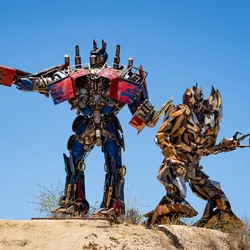
Level 1:
In the 1980s, there was a popular toy called the Transformers. It was different from other toys because it was a robot that could turn into a vehicle. Children loved this toy because they could play with it in many ways. The toy was also very detailed and had many designs. It was fun for children to transform the toy into different things like cars or airplanes. The Transformers were a big part of popular culture and inspired many movies and TV shows. They continue to be loved by people of all ages.
Level 2:
During the 1980s, a toy known as the Transformers gained popularity. Unlike other toys, this was a robot that could change into different vehicles. Children enjoyed playing with it since they had many options to engage with the toy. The Transformers were intricate and had a variety of designs, which provided children with an exciting experience when transforming them into cars or planes.
This toy became quite trendy, inspiring several movies and TV shows, making it a significant part of popular culture. Today, people continue to enjoy the Transformers, and it remains a beloved toy in the minds of many.
Full Story:
The 1980s were a time of significant cultural and technological change, and nowhere was this more visible than in the world of toys. From the Rubik’s Cube to the Cabbage Patch Kids, the decade gave us some of the most iconic toys in history. One toy from that era, however, stands out above the rest: the Transformers.
The Transformers may appear to be just another line of action figures at first glance, but they are so much more. The Transformers, unlike other toys of the time, were not static characters with predetermined personalities and storylines. Instead, they were robots that could transform into a variety of vehicles, each with its own set of abilities and personalities.
This level of complexity was unprecedented at the time, and it quickly propelled the Transformers to the top of the toy market. Children (and adults) couldn’t get enough of these shape-shifting robots, and they quickly became ingrained in popular culture.
But what was it about the Transformers that drew people in? Why did they capture so many people’s hearts and imaginations? To find answers to these questions, we must first examine the psychology behind the Transformers phenomenon.
Malcolm Gladwell discusses the concept of “stickiness” in his book “The Tipping Point,” which states that some ideas, products, or messages are more likely to stick in our minds than others. Because they were both robots and vehicles, the Transformers had an inherent stickiness. Because of this duality, children were able to interact with the toys on multiple levels. They could use the robots as action figures, imagining epic battles between good and evil, or transform them into vehicles and make up their own stories and adventures.
The intricate designs and attention to detail of the Transformers added to their stickiness. Each robot had its own transformation sequence, which added to the excitement and challenge for children. The robots’ ability to transform into anything from cars to planes to dinosaurs only added to their allure.
The ability of the Transformers to tap into our innate desire for transformation and change was perhaps the most important factor in their success. We are hardwired as humans to seek out new experiences, to push ourselves to our limits, and to constantly evolve and grow. This spirit of transformation was embodied by the Transformers, both literally and metaphorically. They were metaphors for what we could become if we accepted and transformed ourselves.
Of course, it’s not just the psychology of the Transformers that fascinates us. Their influence on pop culture cannot be overstated. Transformers have been a staple of entertainment for over three decades, from the hit animated series to the blockbuster film franchise. They’ve spawned a slew of spin-offs, imitators, and even memes.
To summarize, the Transformers were more than just a toy; they were a cultural phenomenon that captured the essence of what it means to be human. They were sticky, complex, and transformative, which set them apart in an era of mass-produced toys. While other toys have come and gone, the Transformers have stood the test of time, inspiring generations of children and adults alike.
Questions:
What made the Transformers stand out among other toys of the time?
How did the Transformers tap into people’s innate desire for transformation and change?
Why were children drawn to the complexity of the Transformers?
Do you think the Transformers’ popularity has endured because of their ability to transform into various vehicles?
In your opinion, do you think the Transformers have had a significant cultural impact?
Fill In the Blanks:
metaphors, allure, intricate, stickiness, imitators, memes, phenomenon, duality, psychology
To find answers to these questions, we must first examine the ________ behind the Transformers ________.
Malcolm Gladwell discusses the concept of ”________” in his book “The Tipping Point,” which states that some ideas, products, or messages are more likely to stick in our minds than others.
Because of this ________, children were able to interact with the toys on multiple levels.
The ________ designs and attention to detail of the Transformers added to their stickiness.
The robots’ ability to transform into anything from cars to planes to dinosaurs only added to their ________.
They were ________ for what we could become if we accepted and transformed ourselves.
They’ve spawned a slew of spin-offs, ________, and even ________.
Difficult Words:
Rubik’s Cube - a three-dimensional puzzle game, where the aim is to solve the cube by arranging all of the squares so that each face shows a single color.
cultural sensation - something that becomes popular in a particular culture and captures the imagination of many people.
phenomenon - an observable fact or event that is particularly impressive or unusual.
innately - having a natural skill or ability for something.
algorithm - a set of rules used to solve a problem, particularly in computer programming.
quintillion - a number equal to one followed by 18 zeros.
captivating - holding the attention or interest of someone.
psychology - the scientific study of behavior and mental processes.
stickiness - the quality of being memorable and able to stick in someone’s mind.
duality - the quality or condition of being dual, or having two parts.
interaction - communication or involvement with others.
intricate - complex and detailed.
allure - the quality of being attractive or fascinating.
metaphors - figures of speech that represent a comparison between two unlike things.
embodiment - a tangible or visible form of an idea, quality or feeling.
pop culture - modern popular culture transmitted via mass media and aimed particularly at younger people.
imitators - people who copy or mimic someone else.
memes - cultural ideas, symbols, or practices that spread from person to person through social media, the internet, etc.




